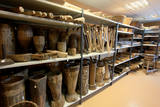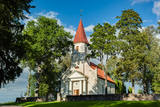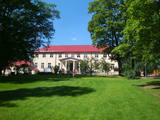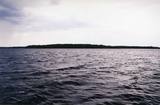| Нo | Название | Описание |
|---|---|---|
|
Название Цесвайне в письменных источниках впервые упомянуто 1209 году. Для каждого путешественника Латвии город связан с родом барона Вульфа, который в 1815 году приобрел имение Цесвайне. Экономический расцвет Цесвайне наступил после строительства железной дороги Плявиняс - Гулбене. Город пострадал во время Второй мировой войны. В конце 2002 года в Цесвайнском дворце произошла трагедия - пожар, который затронул большую часть дворца. Благодаря большой поддержке общественности, государства и самоуправления Цесвайнский дворец обрел и по-прежнему сохраняет статус туристического объекта Видземского и Латвийского масштаба. |
||
|
С мая 2016 года в большом здании Сарканской школы работает Открытое хранилище этнографии и предметов быта Мадонского краеведческого и художественного музея. Здесь есть возможность увидеть, искать и найти прошедшее время, о чем рассказывают предметы, расположенные в уже оборудованных помещениях. Здесь можно увидеть предметы, которые еще не выставлялись в музейных экспозициях и выставках, а школьники, студенты, ремесленники, любой желающий может ознакомиться с ними в исследовательских целях (автор: Инесе Сударе). |
||
|
Одно из сравнительно редких мест, где на побережье можно понаблюдать за рыбаками в работе. Ветряная мельница «Клаюми» (1930 г.) является одним из самых высоких сельских строений. Рядом с мельницей находится Юрмалциемский Туристический информационный пункт, информационный стенд и место для отдыха.Здесь же видны старые деревянные корпуса барж, брошенных рыбаками. Экспозиция«Старинные предметы жителей Юрмалциемса» находится в восточной части поселка, где в деревянном сарае представлены собранные местными энтузиастами предметы быта и орудия труда окрестных жителей. |
||
|
Находится в живописном месте около Ругайского водохранилища. Хозяин выращивает и перерабатывает рыбу. Накрывает столы, на которых присутствуют латгальские блюда. Сотрудничает с крестьянами и рыбакам. Латышская кухня: Копченая рыба (карп, налим из Пейпуса, линь, сом, лещ). Консервы из леща. Из карпа, линя и леща варят рыбный суп. Крупяная каша с копченым мясом, приготовленный на месте ржаной хлеб и сыр. Особое блюдо: Суп-гуляш из линя. |
||
|
The beginning of this circular trail can be found at the Krimulda church – the oldest in Latvia. In one direction, the tourist will pass along the banks of the little Runtiņupīte river (Runtiņš) to the place where it flows into the Gauja river. Among the points of interest along the way are the parsonage of the church, the Kubesele castle hill, a memorial to the Livonian chieftain Kaupo, the Kubesele cave, the Saulstari rock, the “Great Rock”, ancient anchor blocks, ancient graveyards, a unique labyrinth, etc.
|
||
|
Pastāv uzskats, ka tieši Rubenē izveidojusies pirmā latviešu draudze. Baznīcas altārdaļa būvēta jau 14.gs., bet pati baznīca savu pašreizējo izskatu ieguvusi 1739. gadā.Būtiska baznīcas interjera sastāvdaļa ir Ķieģeļu muižas mantinieces Barbaras Helēnas fon Budbergas 1762. gadā dāvinātais kroņlukturis ar Krievijas impērijas divgalvaino ērgli un zaru ornamentiem uz bumbas. Baznīcā redzama arī zīme (1869. g.), kas ir veltīta pusgadsimtam kopš dzimtbūšanas atcelšanas. Pastāv vairākas teikas par Rubenes baznīcas nosaukuma rašanos. Viena no tām vēsta, ka, sargājot baznīcu no velna, tās sienā iemūrēta sieviete un vīrietis, kura vārds bijis Rubens. Baznīca esot nosaukta viņam par godu.Vēl viena versija vēsta, ka baznīcas nosaukums cēlies no rubeņa, kas sēdējis kādā no kokiem, kas vēlāk izmantots baznīcas celtniecībā. |
||
|
Lina, vilnas apģērbu šūšana, galdautu, dvieļu, jostu u.c. tekstilizstrādājumu šūšana. Tērpu darināšana nav tikai darbs, bet arī aicinājums. Tas palīdz izgatavot vissarežģītākās tērpu konstrukcijas. Nemitīgā zināšanu papildināšana kursos ļauj veiksmīgi dzīvot līdzi mainīgajām modes prasībām. Paralēli individuālajiem pasūtījumiem tiek izgatavoti gan apģērbi, gan citi šūtie izstrādājumi tirdzniecībai. |
||
|
Sēļu muiža, par kuru pirmās ziņas saistāmas ar 1561. gadu, ar seno ēku kompleksu un ainavu parku mūsdienās vēl joprojām darbojas kā pagasta administratīvais un kultūras centrs, kur tiek organizēti arī atpūtas un saviesīgi pasākumi. Neskatoties uz to, ka muiža vairākkārt ir tikusi pārbūvēta, tās senatnīgums ir vēl saglabājies. Sēļu pagasta Tautas nams piedāvā bezmaksas ekskursijas Sēļu muižas kompleksā un divas meistardarbnīcas: ādas apstrādes meistardarbnīca pie Benitas Audzes un kokapstrāde un galdniecība pie Uģa Vītiņa. |
||
|
Семейное предприятие предлагает высококачественные продукты традиционного пчеловодства из Национального парка Гауи (~ 150 семей) - мед, пыльца, пчелиный хлеб, воск и прополис и создает новые, небывалые еще на рынке продукты, которые удовлетворяют необычные, но здоровые пожелания клиентов. Экскурсия, покупка меда. |
||
|
Atrodas 1905. gada ielā 6. Sinagoga tika celta 1875. g. – Krievijas cara Aleksandra II valdīšanas laikā. Pēc 2. pasaules kara tajā atradās graudu noliktava, kinoteātris, kafejnīca un visbeidzot – naktsklubs. No 2003. gada to vairs neizmantoja. Pirms gada tika pabeigts vērienīgs projekts - sinagogas un lūgšanu nama atjaunošana, kurā izveidots sabiedrībai pieejams kultūras un informācijas centrs un pārcelta Kuldīgas novada bibliotēka. |
||
|
Sēlijā, 5 km attālumā no Aknīstes, mājā "Skārdupītes" atrodas biedrība “Sēlijas laivas”. Kamēr teritorijā vēl tikai tiek attīstīta aktīvā tūrisma bāze, jau tagad viesiem tiek sniegts ieskats laivošanas kultūras attīstībā, kā arī ir iespējama dažādu laivu veidu noma un laivošanas tehnikas apmācība. Papildus: vides gida pakalpojumi ar iespēju laivojot iepazīt upes ekosistēmu, floru un faunu. |
||
|
Предлагает приобрести продукты пчеловодства: мед различных цветов, лесной, вересковый, липовый мед, цветочную пыльцу, пчелиный хлеб, прополиса и др. Поделится опытом и покажет приусадебную пасеку. |
||
|
Кафе расположено в Стенде, примерно в 12 км от Талси. |
||
|
Cafe Vizbuļi atrodas Bērzciemā, Engures novadā, apmeklētājiem piedāvā nobaudīt gardu maltīti, svaigi ceptas smalkmaizītes, izbaudīt Bērzciema jūru, atpūsties un relaksēties. Ziemas sezonā kafejnīca atvērta tikai nedēļas nogalē, vasaras sezonā - katru dienu, ir āra terase. |
||
|
Просторное кафе в Гулбене с удобными креслами и вкусным предложением дневного меню. Предлагается несколько видов пицц и особые блюда Гулбенского края. Время работы: понедельник – четверг с 10:00 до 22:00, пятница – суббота с 10:00 до 03:00, воскресенье с 11:00 до 22:00. |
||
|
Один из главных остановочных пунктов на Северокурземском побережье, где можно получить обширную информацию и представление об истории края и побережья, культурно-исторических ценностях, строительстве парусников, традициях рыболовства, людях этого края, их труде и заслугах. Музей в Рое был основан в 1968-м году. В настоящее время можно осмотреть постоянные экспозиции о Кришьяне Валдемаре, мореходной школе в Рое и строительстве парусников в 19-м веке. Создана также экспозиция об истории рыбообработки с 19-го века до наших дней, Ливском береге, о советском вкладе в развитие побережья. Кроме осмотра основной экспозиции еще можно «познакомиться» с тремя жительницами Курземе, представляющих различные исторические периоды: Милдочка – простая жена рыбака c побережья, госпожа Паулиня со времен парусников и Анна Петровна с советского времени. Они увлекательно знакомят с предметами, не представленными в музее и со «скверным» юмором жителей Курземе. (Источник: Ройский ТИЦ) |
||
|
Наиболее значимый для города период связан с периодом с1561 по 1795 гг., когда Елгавский край входил в состав Курземского и Земгальского герцогства. Как только Елгава получила статус резиденции герцога (1567 г.) и столицы герцогства (1616 г.), началось быстрое развитие города, которое достигло наивысшей точки во времена правления герцога Екаба. Во время правления двух последних Курземских герцогов – Эрнста Иоганна Бирона и его сына Петра учреждается (1775 г.) Академия Петра (Academia Petrina) - первый Латвийский университет, в 1816 году создается Курземское Литературное и художественное общество, в 1822 г. выходит в свет первая газета на латышском языке «Латвиешу Авизес» («Латышские Газеты»), в 1802 г. строится первое здание театра в Латвии, а в 1898 г. – первое предусмотренное для музея здание. В 1937 г. в Елгавском замке размещается Латвийская Сельскохозяйственная камера, а через два года открывается Елгавская Сельскохозяйственная академия. Летом 1944 года погибает почти вся историческая застройка города и художественные ценности. По окончании Второй мировой войны Елгаву восстановили. Не так давно восстановлена башня церкви Святой Троицы, в которой в настоящее время создан один из лучших интерактивных музеев Латвии (очень дружественный по отношению к семьям с детьми). |
||
|
Ремесленники предлагают экскурсию, наблюдение за процессом рождения керамики и возможность самому изготовить свои сувениры, используя технику формирования, точения и гравировки на заранее подготовленных формах. Заказ и покупка керамических изделий. Место полюбили дети и новобрачные. |
||
|
Seno un mūsdienīgo amatu prasmju popularizēšana, izkopšana un tālāknodošana. |
||
|
This is Latvia’s oldest nature reserve and, indeed, the country’s oldest protected natural territory. Moricsala is an island in Lake Usma, which is the fifth largest lake in Latvia. The reserve was established in 1912 at the initiative of a group of nature students from Rīga. They wished to protect the deciduous forest of oak trees on the island, along with the local flora and fauna. The nature reserve also includes the Lielalksnīte island. Visits to the reserve, however, are strictly prohibited. |
||




















